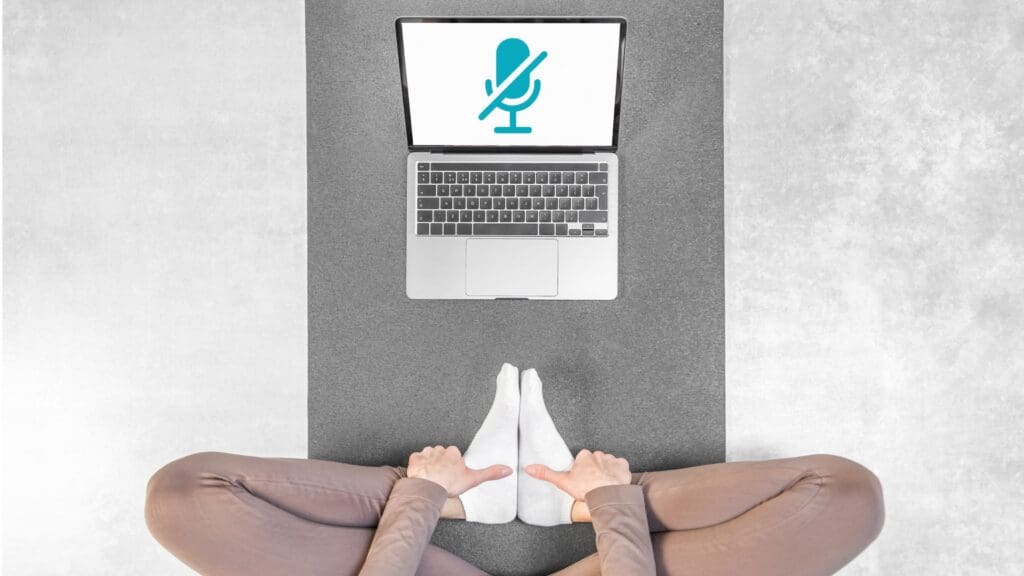You’re On Mute! 10 Common Mistakes We Make When Teaching Office Yoga Online

Interested in learning how to teach Office Yoga online? Visit our training page.
How often are you on a virtual video chat and have someone say the familiar words, “You’re on mute!” Chances are, you are that person or have told someone else they’re on mute. Speaking on mute is a common mistake we all make. Live video platforms have gone from being a company meeting tool to a platform for concerts, family reunions, and yoga classes.
The yoga community has also adopted the virtual teaching format. However, the experience of teaching Office Yoga online differs from teaching in person. If you’re a yoga teacher, you probably experienced this transition. We shifted from guiding students in a yoga studio or boardroom to teaching on a conferencing platform overnight. It was hard to “read the room” and know what students were doing. However, online teaching has become more proficient over time and with tapas (discipline).
Online Office Yoga classes have proliferated, especially in companies with hybrid workforces. Basic yoga teacher training, however, does not cover teaching yoga online. Here are some common mistakes I see people make in Office Yoga Teacher Training and some simple ways to fix them.
Clear the Space
Clear your background space of clutter and images. Just as you would clear a conference room when teaching in person, clear the desk, floor, and wall space when teaching virtually. When I teach Desk Yoga virtually, I clear my desk of pens, post-it notes, and water glasses that are commonly on my desk. I have a blank wall behind me. I clear the floor of any distractions, as well. I may be guilty of having too many plants, but I’m working on it! Think of this as a practice in sauca (cleanliness), one of the ethical guiding principles in yoga. Less is more when it comes to teaching spaces.
Know Your Video Conferencing Platform

Be the first to get Office Yoga tips and inspiration here!
Companies may request specific video streaming platforms like WebEx, Teams, Zoom, Google Meet, or Ring Central. Each platform has a specific video span, tools, and capabilities. Before the session begins, familiarize yourself with the requested platform. If you prefer to play music or use visuals, familiarize yourself with how to share audio/screen. What’s most important to focus on here is capturing your full body through the lens.
Cameras On vs Cameras Off
One of the advantages of teaching office yoga online is the flexibility it offers students. Your camera should always be on as the teacher, but students have the choice; most of the time, they choose to turn the cameras off. Many teachers can get thrown off by this, and there’s a simple solution. At the start of the class, I suggest saying, ‘If you’re comfortable, feel free to turn your camera on. I’d love to be able to provide feedback. But I understand if you’re still in your pajamas and prefer to leave your camera off.’ A gentle reminder at the beginning of every session can persuade those on the digital fence.
Lights, Camera, SPOTLIGHT
When teaching a virtual class, spotlight your camera so you are the only one on the screen. If you’ve arranged for another teacher to demonstrate the sequence while you provide feedback, spotlight that teacher. This is especially important if you’re recording the session. Companies have strict privacy disclosures, and employees may not want to be recorded during practice and then have it shared company-wide. Ensure you are spotlighting your camera so you are the only one on the screen. This will make employees feel comfortable leaving their cameras on during the session.
Look Ma, No Hands!
Make sure that your hands and feet are always visible during the practice. A good rule of thumb is to have the camera at hip height and then step back about two body lengths. This will vary depending on your height and the room you’re teaching in. Set up your camera for a few minutes before class to ensure you’re visible. Step back as far as you can and reach your arms over your head. Be sure you can see your hands and feet on the screen, and teach from that distance.
Mirror Your Students
If you’ve seen the Lululemon Studio Mirror, the instructor mirrors the workout the entire time. An entire “mirror workout” industry is built on this principle of reflection. When facing the camera, mirroring your students gives them the opportunity to follow along without getting confused. Mirroring is less important if you’re teaching at a 90-degree angle from the camera. Students will follow the bigger movements, like stepping one foot forward under the edge of the desk or stepping back into a downward-facing dog. If you’re in a lunge position at a 90-degree angle and add a twist, ensure you’re twisting towards the camera. You may do the same side twice unless you’re demonstrating something important from behind that warrants turning your back to the camera.
Use a Mic
People are more forgiving about visual quality than sound quality. If you must improve sound and camera quality, start with sound. Most computers have good sound quality, but this can be an issue if you are in a busy neighborhood or don’t have a quiet space to teach from.
Use AirPods with built-in microphones or a wireless microphone system to improve your sound quality. Click here to see suggested wireless microphone options.
Playing Music in a Corporate Yoga Class
On the topic of sound, many teachers prefer to play a curated playlist. Personally, I don’t play music, but I don’t feel strongly either way. On the plus side, music can change the tone of the atmosphere and invoke specific moods more effectively.
However, music can distract students from their practice. When that high-beat tempo comes on during the quiet, grounding part of your sequence, you’re suddenly playing DJ instead of paying attention to your students. Music can also invoke memories and pull students away from their bodies and into a storyline of the past. If you choose to play music, be intentional about how you curate your playlist.
Check Your Visual Quality

Interested in becoming a certified Office Yoga instructor? Learn more.
Teaching office yoga online requires clear visual quality. Investing in a computer with good camera quality is worthwhile, but that’s not always an option. The pandemic created a surplus of clip-on video cameras you can purchase for higher resolution. If your computer camera quality is low, consider a webcam for higher resolution. Click here to see suggested webcam options.
Houston, We Have a Problem
The final consideration is your internet connection. An ethernet cable is the most secure way to connect to the internet without interruption. In most urban areas, internet connection is accessible, but losing connectivity happens. If you’re traveling somewhere new, connect in advance to ensure your connection is stable. A hot spot can be an alternative if the internet connection is spotty. For best results, schedule classes when you know you will be in a quiet space or reschedule if you are on the road.
To improve your online teaching of office yoga, watch the recordings of your videos. Would you take this class? Does watching your own video inspire you to practice? If not, why? Often, one of the simple fixes listed above can greatly improve your online yoga content.
Interested in teaching corporate yoga classes? Office Yoga Teacher Training certifies instructors to teach onsite and virtual yoga classes for companies worldwide.
